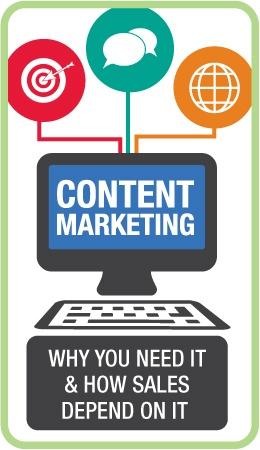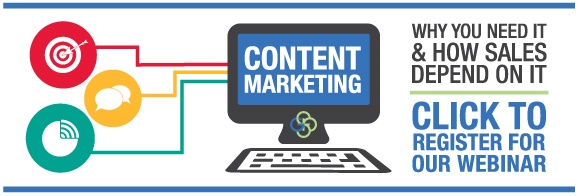A Content Marketing Plan Is all about Sales
You’re comfortable doing business the way you’ve been doing it for years. We get that. But there’s an inherent problem with that. Your customers and prospects aren’t; their buying habits have changed—dramatically. Technology has been driving this content marketing train for a while now, and the painful reality is that if you don’t jump onboard, your potential customers will be leaving the station without you. Stale metaphors aside, you really need to get on track with how business is being done and create a content marketing plan. Okay, bad puns behind us now, let’s get to the meat of it.

Because here’s what’s up with purchasing habits—and you’d better be ready:
- 60% of B2B prospect due diligence is done before contacting sales person (per Tim Riedel, Intuit)
- Nurtured leads produce, on average, a 20% increase in sales opportunities versus non-nurtured leads. (DemandGen Report)
- Customers are generally 70% down the funnel prior to contacting a sales person—leaving you only 30% of their journey to engage with them. By this time, they’ve already narrowed down the vendor field, so you are sharing that valuable time with competitors.
And, most stunningly …
- By 2020, customers will manage 85% of their relationships without talking to a human. (Gartner Research, via a Salesforce blog)
Whoa! That precious 30% of their time will shrink to a tiny window of diminished human interaction all together. So 15% of interactions will be human to human, and of that—even if we use today’s stats of people being 70% down the funnel by the time they talk to you (which will likely increase by then)—that is mind blowing. At the recent megamarketing conference, INBOUND 2015, Daniel Pink, the event’s final keynote speaker, reminded us that the old adage, “Buyer beware,” has shifted to: “Seller beware.”
Why? And of what? How do you address this ominous warning?
The Why of Things
I’ll give you a hint: Google. I’ve been there. You’ve been there. Your friends go there. So do your customers and your future customers. Understand this: content marketing is not the future of marketing … and purchasing … and selling … and servicing. It is how business is being done now. At work. At home. While sipping a latte at the corner coffee shop. In an airplane. On vacation. At 4 a.m. In the midnight hour. You get the picture. Consumers—both B2B and B2C—expect and demand to be informed. They want the info when they want it, at their convenience. And they are more than happy to inform each other of any successes and missteps along the way. At Grant Marketing, we run content marketing workshops. In them, we discuss purchasing habits among participants. Consistently and most prevalently, there is one purchasing habit that is common among people, once they’ve found their product of choice (or narrowed it down to a small field): peer reviews.
In the B2B community, these might be presented as case studies—and we know those are carefully prepared—but they also offer valuable intel about the capabilities of the companies on both sides of the equation. A well-documented case study helps prospects see how their needs can be met—even exceeded—in a similar way. More so, it may inform them that they can stretch their core capabilities because of Company A’s abilities to turn things around for Company X. They download the case study, become leads, get wooed, and become delighted customers. All with the help of a thoughtful content marketing strategy.
What Else Does Content Marketing Consist of?
Glad you asked. And you’re right, it’s not that simple. There is more to it. It actually begins with a mobile-friendly website that is loaded with relevant content on each page. Most commonly, we think of it in terms of blogs, case studies, and white papers. Moving up quickly in popularity and effectiveness are infographics and video. Pulling them all together are a series of calls-to-actions (CTAs) and landing pages. It’s largely a linear relationship with some complexity and overlap (the kind of stuff that your marketing department takes care of).
The Sales Connection
Most important are the touch points that directly include, reach, and impact sales.
Voice in Content: When done effectively, salespeople should have a direct voice in building the content library—in everything from blogs, case studies, whitepapers, videos, etc. Customer facing, the sales team knows, firsthand, what’s on the minds of the prospects and customers. This valuable information should absolutely be mined for use in all content channels.
Forms: Forms are placed on landing pages and ask those questions we all think twice about answering or not. “Do I really want to be placed on another mailing list or be hounded by this company?” We all know that drill. But … this is exactly why they are fantastic lead qualifiers. If people are willing to fill out the form, we can make some assumptions:
- They are really interested in the information to be shared in the downloadable content offering (in other words: they have a problem that needs a solution, and they are hoping this company can provide it).
- They don’t mind be contacted by the company offering said info/fix.
- They have a genuine interest in the company and its product and/or services.
- They are really efficient at managing their unsubscribe notices.
Tracking Web Visits: What’s hugely helpful for sales in this mix is that marketing should be working with their sales people to understand what qualifying info they want gathered on these forms. The amount of info gathered usually corresponds with where the person might be in the sales cycle. Top-of-the-funnel (TOFU) queries usually only require a name and an email address—often only an email address. If your company is using a real-time marketing and sales software platform, an email address is enough to begin tracking each individual’s visits to your website. A robust marketing and sales platform like HubSpot can allow you to use “smart tracking,” so when a person who has previously filled out a lead form comes back to the website and fills out another CTA form, it won’t ask for that same info. But—and here’s the magic of seeing people progress down the funnel—as the content offerings get meatier, people are willing to give more information to acquire them.
Qualifying Leads: Here is where the real qualifying begins. Say you have a manufacturing company that takes business on when companies are within six months of production readiness. As a drop-down question in the form, for example, you would ask a question pertaining to the prospect’s window of time for production. If your sales team is segmented by geography or customers’ monetary tiers or company size, the questions you ask will pertain to those qualifying questions. You’ll have direct information that will help you determine which leads are hot or not. The “magic” in providing well-rounded content—some that offers general information; some that is very specific and focused—is that many prospects naturally qualify themselves. By reading the info you provide, they either sense that they are not a great fit for you (or vice versa), or they readily self-identify with you—which is directly connected to your brand voice that communicates throughout your content—all of which is implicitly a part of a content marketing plan.
Lead Intelligence: There is so much more lead intelligence you can mine, as well—but that’s another post! I will say this about real-time lead intelligence when using a marketing and sales software platform. Because you can see exactly where people are on your website (down to the seconds they are on each page), you are informed of your prospects’ interests so you can tailor (nurture) the marketing automation (emails, landing pages, and CTAs) to respond to and correspond fluidly with their journey. As more of their questions are being answered by your ever-ready content, their trust in you builds. It is an efficient use of time: you aren’t wasting theirs (how thoughtful of you) or yours. And because they come knocking at your proverbial door pretty well informed, your time and efforts are streamlined later, when you finally make contact.

Are the Scare Tactics Real?
Seller beware, huh? Well, there are real concerns about keeping up with the time, the technology, and the purchasing patterns of consumers. Outdated websites can convey an antiquated first impression. Aside from Google’s inability to find you in the cyber clamor of awesome offerings, anemic content can communicate an attitude of apathy towards customers’ concerns. Having ready-made content available at the convenience of potential prospects, 24/7, is categorically a real commodity to them.
And your hottest, best, and most successful commodity as you prepare for the future.
If, in just five years, only 15% of the purchasing pie will be shared human-to-human, companies that don’t have a content marketing plan in place will not get their slice. The “selling” (a.k.a. educating) of prospects and customers will be done so largely by your tireless sales team member: your website. Wow—that’s staggering. You can think of this as your “BOO!” moment (Halloween is around the corner), or your “Boohoo” moment. Your choice. Either way, getting a content marketing plan in place is the safest bet in town.
If you are wondering how to create a content marketing strategy for your company, you’re in luck! We have an upcoming webinar on Wednesday, October 14 at 1:30 p.m. EDT that will show you how. Click here to register.



